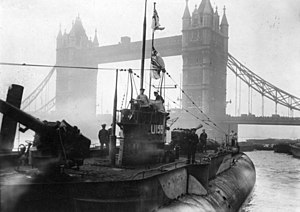German Type U 151 submarine

U-155, a Type U 151 U-boat exhibited in London after the First World War.
|
|
| Class overview | |
|---|---|
| Builders: | |
| Operators: |
|
| Completed: | 7 |
| General characteristics | |
| Displacement: |
|
| Length: |
|
| Beam: |
|
| Height: | 9.25 m (30 ft 4 in) |
| Draught: | 5.30 m (17 ft 5 in) |
| Installed power: |
|
| Propulsion: |
|
| Speed: |
|
| Range: |
|
| Test depth: | 50 metres (160 ft) |
| Complement: | 6 officers, 50 enlisted |
| Armament: |
|
Type U 151 U-boats were a class of large, long-range submarines initially constructed during World War I to be merchant submarines and later used by the Kaiserliche Marine (Imperial German Navy).
In addition to the cargo-carrying submarines Deutschland and Bremen (lost on a cargo voyage in 1916 while it was still a merchant submarine), six further large cargo submarines were ordered, originally designed to ship material to and from locations otherwise denied German surface ships, such as the United States.
On 16 December 1916, four under construction in the Reiherstieg and Flensburger Schiffbau yards were taken over by the navy and converted to military specification as Type U 151 U-boats, being designated U-151 to U-154. The remaining two, along with the Deutschland, which became U-155, passed into naval control in February 1917, as U-156 and U-157.
All were fitted with two bow torpedo tubes and could carry 18 torpedoes, with the exception of the former Deutschland, which was fitted with six tubes. All were armed with two 15 cm deck guns, and carried a crew of 56. They had a cruising range of around 25,000 nautical miles (46,000 km; 29,000 mi).
The success of the Type U 151 submarines led to "Project 46", the larger Type U 139 "U-cruisers", designed from the outset as military submarines.
...
Wikipedia
